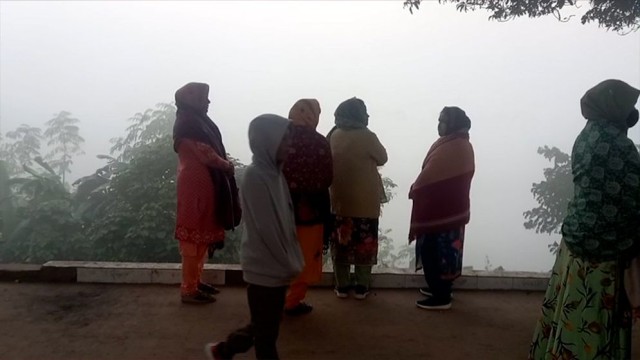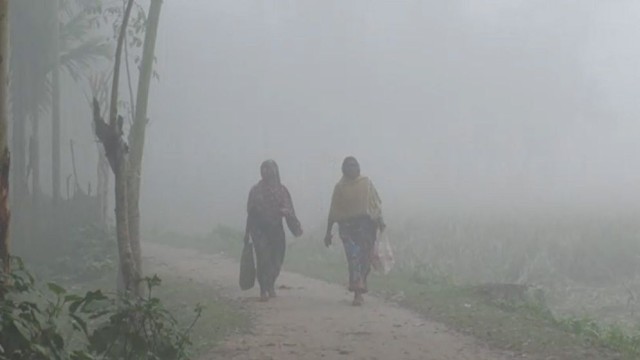Dhaka, Dec 16, (V7N) - Today, December 16, the 54th Victory Day of Bangladesh, Dhaka has ranked second among the 125 most polluted cities worldwide, according to air quality data. At around 10:00 AM today, the air quality in Dhaka was recorded at 302, which is considered hazardous. This level of air pollution is a significant concern for public health.
India’s capital, Delhi, topped the list with a score of 427 on the Air Quality Index (AQI). Dhaka's air quality has reached dangerous levels today, and this comes after similar hazardous conditions on December 2 and 5. According to the AQI system, an air quality level above 300 is categorized as hazardous. If air quality stays at hazardous levels for three continuous hours over three days, it typically triggers an emergency health warning.
Pollution Hotspots in Dhaka
The areas with the most severe pollution today are West Nakhalpara Road (441 AQI), Hemayetpur in Savar (354 AQI), and Becharam Dewri in Old Dhaka (344 AQI). These readings are alarming, as the Air Quality Index helps people understand the level of cleanliness or contamination in the air and indicates potential health risks.
The AQI is calculated based on five major pollutants: particulate matter (PM10 and PM2.5), nitrogen dioxide (NO2), carbon monoxide (CO), sulfur dioxide (SO2), and ozone (O3). According to experts, when the concentration of particulate matter (PM2.5) in the air is between 0 and 50 micrograms per cubic meter, the air is considered “good.” A level between 51 and 100 is categorized as “moderate,” while an AQI between 101 and 150 is considered “unhealthy for sensitive groups.” Air quality with an AQI between 151 and 200 is “unhealthy,” between 201 and 300 is “very unhealthy,” and anything between 301 and 500 is considered “hazardous.”
Health Risks of Air Pollution
Air pollution poses severe health risks, particularly for all age groups. Children, the elderly, pregnant women, and individuals with pre-existing health conditions, such as respiratory and cardiovascular diseases, are especially vulnerable. The particles in polluted air can cause or aggravate conditions like asthma, bronchitis, and even cancer. Prolonged exposure can lead to chronic respiratory diseases, strokes, and heart conditions.
According to the World Health Organization (WHO), air pollution significantly contributes to the global mortality rate, causing an estimated 7 million deaths annually worldwide. The primary sources of air pollution in Dhaka are brick kilns, vehicle emissions, and dust from construction sites. A report published by the Environment Department and the World Bank in March 2019 pointed out that these three factors are the major contributors to the city’s poor air quality.
Expert Recommendations
In light of the current air pollution levels, experts have offered the following advice to protect public health:
-
Wear Masks: When going outdoors, people should wear N95 masks or any other masks that can effectively filter out fine particulate matter.
-
Avoid Outdoor Physical Activity: Avoid exercising or any strenuous physical activity outdoors, as it increases the intake of harmful pollutants.
-
Keep Windows Closed: To minimize exposure to indoor pollution, it’s essential to keep windows and doors closed, especially in areas where pollution is more intense.
-
Stay Indoors: People, especially vulnerable groups such as children and the elderly, should stay indoors as much as possible to avoid inhaling harmful particles.
-
Use Air Purifiers: If available, use air purifiers indoors to reduce the concentration of pollutants in the air inside homes or offices.
The Environment Department and other agencies are continually monitoring air quality in the city, but individuals should take immediate precautions to safeguard their health. The conditions of today’s air quality serve as a stark reminder of the long-standing issue of pollution in Dhaka, especially during the winter months.
Conclusion
Dhaka’s air pollution problem is a serious and persistent threat, especially during winter, when air quality often worsens due to various factors. As we commemorate Victory Day, it is crucial to recognize the need for more aggressive measures to tackle air pollution and its harmful effects on public health. Authorities and citizens alike must collaborate to improve the city’s air quality by addressing pollution sources, enforcing environmental regulations, and taking steps to ensure a healthier environment for future generations.
For today, given the hazardous air quality, it is essential for people to stay informed and take necessary precautions to protect their health.
END/SMA/AJ/































Comment: